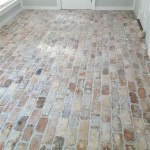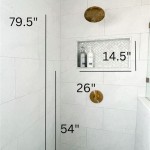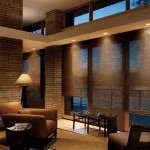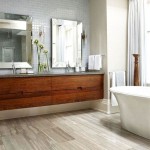Dark Floor vs. Light Floor: A Comprehensive Comparison for Interior Design
The selection of flooring is a crucial decision in any interior design project, significantly impacting the aesthetics, atmosphere, and functionality of a space. Among the myriad of options, the choice between dark and light flooring is particularly impactful. Both options offer distinct advantages and disadvantages, making the selection process a careful balancing act dependent on various factors such as room size, natural light availability, desired style, and maintenance considerations. This article provides a comprehensive comparison of dark and light flooring, examining their key characteristics and offering insights to assist in making an informed decision.
Aesthetic Impact and Perceived Space
One of the primary considerations when choosing between dark and light flooring is the aesthetic impact each has on the overall appearance of a room. Light flooring, generally, creates a sense of spaciousness and airiness. Its reflective qualities amplify natural light, making rooms feel brighter and more open. This is particularly beneficial in smaller rooms or those with limited natural light, where light flooring can help to counteract a feeling of confinement. Light-colored floors also tend to project a cleaner, more minimalist aesthetic, often associated with modern and contemporary design styles.
Conversely, dark flooring creates a sense of depth and intimacy. It tends to absorb light, contributing to a cozier and more grounded atmosphere. Dark floors can make large rooms feel more manageable and inviting. They also provide a striking contrast to lighter walls and furniture, creating a visually dynamic and sophisticated look. Dark flooring is often associated with traditional, formal, or luxurious design styles.
The perceived size of furniture can also be influenced by the flooring choice. On a light floor, dark furniture stands out, creating a strong visual anchor. In contrast, lighter furniture blends more seamlessly into the background, allowing the eye to travel more freely across the space. With dark floors, light furniture provides a necessary contrast to prevent the room from feeling too heavy or closed in.
The overall desired style strongly influences whether dark or light flooring is more suitable. Scandinavian and minimalist aesthetics often favor light floors to maximize brightness and create a sense of simplicity. Traditional and formal styles often incorporate dark flooring to convey elegance and sophistication. Transitional styles may incorporate either dark or light flooring, depending on the specific design elements and the desired balance between modern and traditional influences.
Maintenance and Durability Considerations
Maintenance is another critical factor to consider when choosing between dark and light flooring. Dark floors tend to show dust, dirt, and scratches more readily than light floors. This is because the contrast between the dark surface and lighter-colored debris or imperfections is more noticeable. As such, dark floors generally require more frequent cleaning and maintenance to keep them looking their best. This is especially true in high-traffic areas or households with pets.
Light floors, on the other hand, are more forgiving when it comes to concealing dust and dirt. Light-colored surfaces tend to camouflage these imperfections, requiring less frequent cleaning to maintain a presentable appearance. However, light floors are more prone to showing stains. Spills and dark-colored substances can leave noticeable marks on light flooring, requiring prompt cleaning to prevent permanent discoloration. The specific type of light flooring material also influences its stain resistance; certain materials, such as porcelain tile, are more resistant to staining than others, such as light-colored carpets.
The durability of flooring is also an important consideration. The durability of flooring is influenced by the material itself rather than the color in most cases. Hardwood, tile, laminate, and vinyl all offer varying degrees of resistance to wear and tear. However, the finish applied to the flooring can impact its resistance to scratches and scuffs. For example, a matte finish on dark hardwood may be more effective at concealing minor imperfections than a high-gloss finish. Conversely, a light-colored tile with a textured surface may be better at hiding scratches than a smooth, polished tile.
The lifestyle of the occupants significantly impacts the maintenance requirements. Households with children or pets may benefit from flooring options that are both durable and easy to clean. Those who prioritize low-maintenance solutions may opt for light-colored flooring options that are less prone to showing dirt and dust. Conversely, individuals who are meticulous about cleanliness and appreciate a sophisticated aesthetic may be willing to invest the time and effort required to maintain dark flooring.
Impact on Lighting and Ambiance
The choice between dark and light flooring profoundly impacts the overall lighting and ambiance of a space. Light flooring reflects light, effectively increasing the perceived brightness of a room. This is particularly advantageous in rooms with limited natural light, such as basements or interior spaces. Light floors can help to create a more cheerful and inviting atmosphere, promoting a sense of well-being. The reflective qualities of light flooring also enhance the effectiveness of artificial lighting, reducing the need for excessive light fixtures or high-wattage bulbs.
Dark floors, in contrast, absorb light, creating a more subdued and intimate ambiance. This can be desirable in bedrooms or living rooms, where a relaxing and cozy atmosphere is preferred. However, in rooms with limited natural light, dark floors can exacerbate the feeling of dimness, making a space feel smaller and more enclosed. To counteract this, it is crucial to incorporate ample artificial lighting to compensate for the light absorbed by the dark flooring.
The color temperature of the lighting should also be considered in relation to the flooring choice. Warm-toned lighting, with its yellow or orange undertones, can complement dark flooring, enhancing its inherent warmth and creating a cozy atmosphere. Cool-toned lighting, with its blue or white undertones, can brighten up a room with dark flooring, preventing it from feeling too somber. Conversely, warm-toned lighting can make light flooring appear even brighter and more inviting, while cool-toned lighting can create a more crisp and modern aesthetic.
The interplay between natural and artificial light is critical in determining the ideal flooring choice. In rooms with abundant natural light, either dark or light flooring can be successfully implemented, depending on the desired aesthetic and ambiance. In rooms with limited natural light, light flooring is often the preferred choice to maximize brightness and create a sense of spaciousness. However, with careful consideration of lighting fixtures and color temperature, dark flooring can still be effectively utilized in such spaces, albeit with a greater emphasis on artificial lighting solutions.
The overall stylistic direction of the interior design scheme also plays a role in determining the optimal lighting strategy. Modern and minimalist designs often favor bright, evenly distributed lighting to complement the clean lines and uncluttered aesthetic. Traditional and formal designs may incorporate a more layered lighting scheme, with a combination of ambient, task, and accent lighting to create depth and visual interest. The flooring choice should be carefully considered in relation to the overall lighting strategy to ensure a cohesive and harmonious design.
Ultimately, the selection of flooring color is a subjective decision influenced by individual preferences, aesthetic goals, and practical considerations. By carefully evaluating the factors outlined above, including aesthetic impact, maintenance requirements, and influence on lighting and ambiance, one can make an informed decision that results in a beautiful, functional, and personalized living space.

Light Or Dark Hardwood Floors Dan Custom

How To Choose Between Dark And Light Flooring Mississauga

Light Or Dark Wood Flooring How To Decide Esb

Light Vs Dark Flooring Settling The Eternal Debate Imagine Floors

Dark Vs Light Flooring What Should I Choose For My New Home Build Reinbrecht Homes
%202.jpg?strip=all)
Light Vs Dark Hardwood Flooring America

Light Vs Dark Wood Flooring How To Decide Greyspace

Dark Floors Vs Light Eastman S Carpets Inc

Pros And Cons Of Dark Vs Light Hardwood Floors

Light Vs Dark Which Floors Will You Choose Factory Flooring Liquidators







